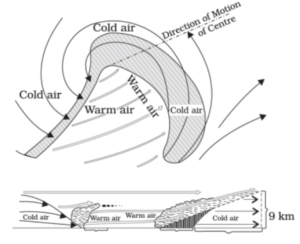3 Feb 2024 : Daily Answer Writing
Q1) Define air mass and explain the influence of different types of air masses on weather patterns. (250 Words/ 15 Marks)
ANS
An air mass is a large body of air which has uniform characteristics in terms of temperature, moisture content and lapse rate. However, the sheer size and expanse of the air mass mean that uniformity must be seen in a general sense and not in a specific manner.
The characteristics of Air mass can be seen from:
- Air mass can extend up to thousands of kilometers horizontally on earth’s surface and up to the top of the troposphere vertically. The boundary between two air masses is called front.
- The properties of air masses are determined by the underlying surface properties where they originate (i.e., source regions).
E.g., warm tropical and subtropical oceans, subtropical hot deserts etc.
- Air mass does not remain stationary but move out of source region. When air mass circulates, it carries the native weather conditions (hot/cold/ dry/moist) from the source region to the new region.
- Air mass displaces residual air over locations it visits thus impacting the weather conditions.
Influences of different type of air masses on weather pattern can be seen from:
- Air masses help in maintaining latitudinal heat balance by transferring heat from the tropical regions to Polar Regions.
- Depending upon its property (as per source regions), different air masses influence the weather of the concerned region differently.
E.g., the maritime tropical air mass produces warm and humid conditions along the Caribbean islands; the continental tropical air masses produce hot and dry conditions in the Southwest U.S. and Mexico.
- Air masses are also a contributory factor behind generation of heat waves.
E.g., the air mass originating from African desert leads to high temperature and heat waves across Europe.
- Cyclonic circulations:
Air mass aids in creation of cyclonic conditions.
E.g., when cold air mass lies partially over warm water and over land surface (cold) cyclonic conditions are created.
Temperate cyclones are formed when the warm and humid airmasses from the tropics interact with dry and cold air masses from the poles (polar front theory).
When a cold air mass enters a warm region, it is heated from below and thus normal lapse rate increases and air becomes unstable.
E.g., Lake-effect snow, lake-effect blizzards etc.
Figure: Air masses and fronts
- Frontogenesis:

Figure: Temperate cyclone formed due to interaction of cold and warm fronts
- When two air masses converge, they form Front which is associated with major weather changes.
E.g., Cold fronts are marked by strong winds, formation of cumulonimbus clouds and sudden drop in temperature bringing heavy precipitation.
- Stationary front produces clouds for prolonged period due to upward movement of air leading to prolonged precipitation.
As discussed above, the significance of the air masses can be understood from their seminal role in determining conditions and variability of weather in any region.
Upload Answer here


